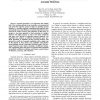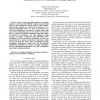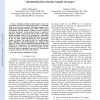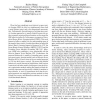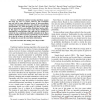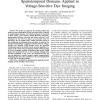ICDM
2009
IEEE
14 years 26 days ago
2009
IEEE
In this paper, we restudy the non-convex data factorization problems (regularized or not, unsupervised or supervised), where the optimization is confined in the nonnegative orthan...
ICDM
2009
IEEE
14 years 26 days ago
2009
IEEE
Anomaly detection is an important data mining task. Most existing methods treat anomalies as inconsistencies and spend the majority amount of time on modeling normal instances. A r...
ICDM
2009
IEEE
14 years 26 days ago
2009
IEEE
The design of a good kernel is fundamental for knowledge discovery from graph-structured data. Existing graph kernels exploit only limited information about the graph structures bu...
ICDM
2009
IEEE
14 years 26 days ago
2009
IEEE
Given a large transaction database, association analysis is concerned with efficiently finding strongly related objects. Unlike traditional associate analysis, where relationships ...
ICDM
2009
IEEE
14 years 26 days ago
2009
IEEE
Clustering streaming data requires algorithms which are capable of updating clustering results for the incoming data. As data is constantly arriving, time for processing is limited...
ICDM
2009
IEEE
14 years 26 days ago
2009
IEEE
Clustering methods usually require to know the best number of clusters, or another parameter, e.g. a threshold, which is not ever easy to provide. This paper proposes a new graph-b...
ICDM
2009
IEEE
14 years 26 days ago
2009
IEEE
There has been significant recent interest in sparse metric learning (SML) in which we simultaneously learn both a good distance metric and a low-dimensional representation. Unfor...
ICDM
2009
IEEE
14 years 26 days ago
2009
IEEE
Traditional machine learning algorithms assume that data are exact or precise. However, this assumption may not hold in some situations because of data uncertainty arising from mea...
ICDM
2009
IEEE
14 years 26 days ago
2009
IEEE
Discovering episodes, frequent sets of events from a sequence has been an active field in pattern mining. Traditionally, a level-wise approach is used to discover all frequent epis...
ICDM
2009
IEEE
14 years 26 days ago
2009
IEEE
We present an approach for learning models that obtain accurate classification of large scale data objects, collected in spatiotemporal domains. The model generation is structured ...

